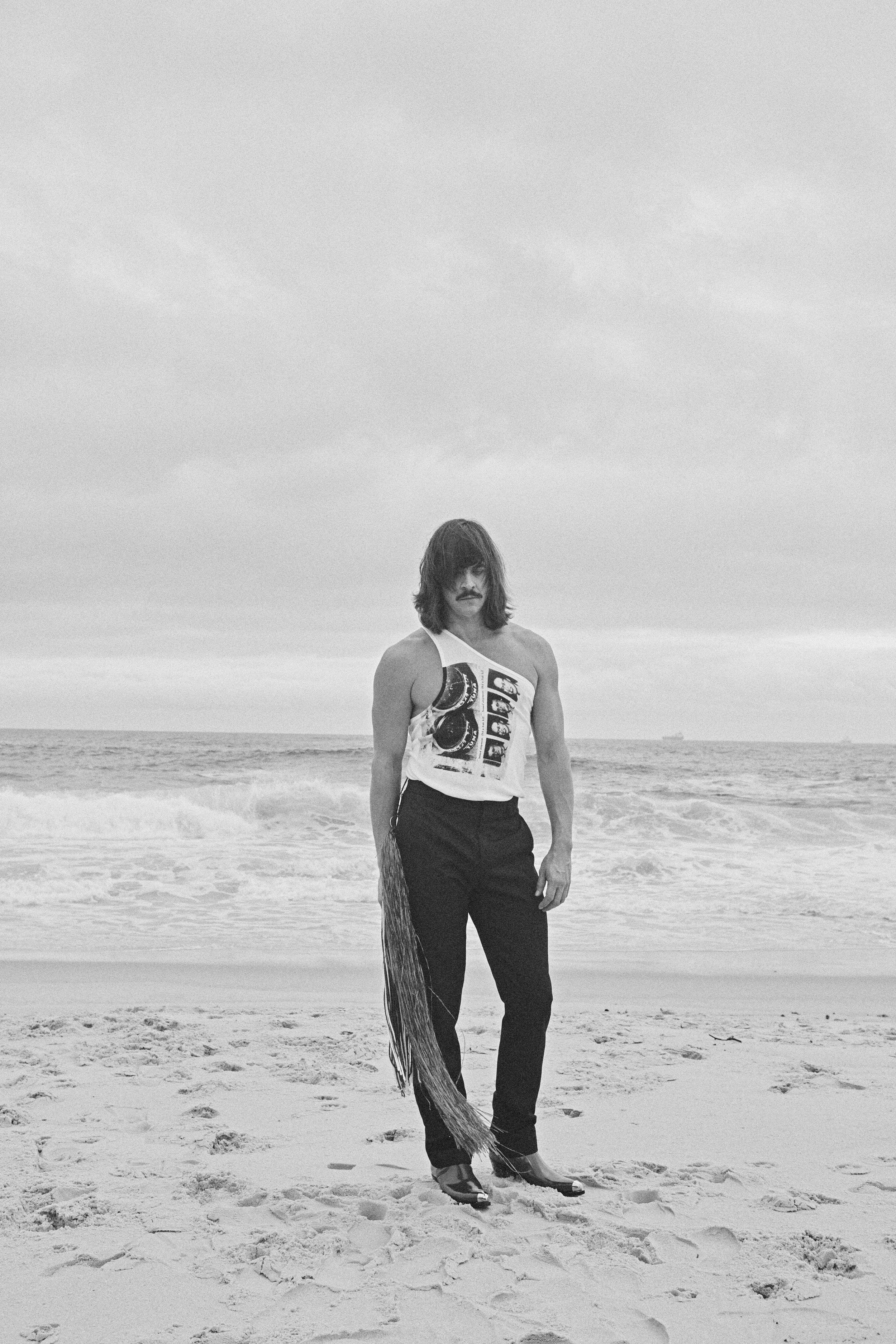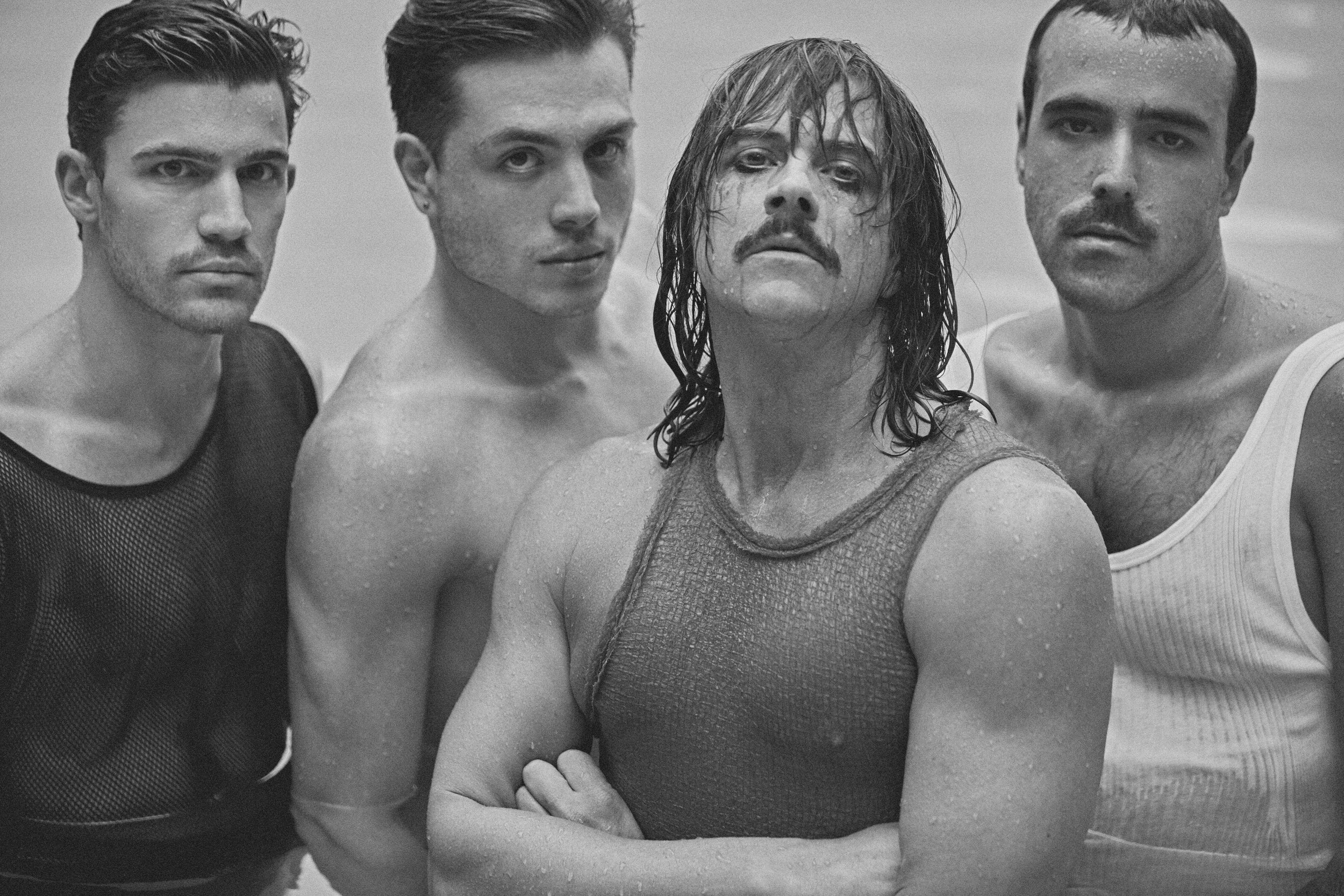Fischerspooner | From Certain Angles, Christ the Redeemer Looks a Bit Like Casey Spooner
by Flaunt Editorial Staff
Fashion Credits, left to right: On Casey - PRADA shirt and FENDI shorts. Models’ own shorts.
In the second half of 2016, Casey Spooner— one part of the influential “electroclash” music duo Fischerspooner, along with producer Warren Fischer—found himself on the edge of a “nervous breakdown.” The man that lit up dancehalls in the early aughts with irresistible hits and championed queer culture during the days of DOMA had fallen on hard times. “I had a major relationship fall apart; I had a financial crisis because I had put all my time, energy, and money into a record that wasn’t coming out,” he tells me over the phone from Paris, where he’s lived since December. “Then my building [in New York City] was sold and I got evicted. I was basically homeless and destitute and brokenhearted and a complete mess.”
CALVIN KLEIN 205W39NYC; Printed artwork: Andy Warhol, Tunafish Disaster, 1963 © The Andy Warhol Foundation tank top, pants, shoes, and pom pom.
The album that encapsulates this tumultuous period, SIR, is due out next month, and it’s an act of protective witnessing set to spiky, frequently propulsive electronic beats. By providing unflinching reports from the front lines of his post-breakup love-life—the agony and the ecstasy and the broken dreams and glorious dancefloor hook-ups, sometimes all within the same song— Spooner can potentially cushion the blow for listeners who are going through similar things. “I want to help queer people,” the 46-year-old singer says. “I’m realizing I have a responsibility to a younger generation to try to share my experiences and help them grow.”
SIR is the work of a radically different musician than the one who released Entertainment nine years ago.When Spooner’s long-term relationship crumbled, he was suddenly single for the first time in 14 years. “I immersed myself in contemporary queer culture in ways that I never really did in the past,” he says. “A lot of people thought I was having a mid-life crisis because I’m way too old, I’m going to circuit parties, working out and being very promiscuous.”
Left to right: HANRO briefs. Model’s own shorts. PRADA top, ZIMMERLI briefs, and talent’s own sunglasses.
These experiences infiltrated his music, prompting him to compose songs with the aim of “trying to emotionalize queer sexuality.” “I think there’s a real issue in gay culture where sexuality, in a lot of ways, is void of emotion,” he says. Although Spooner started writing SIR on January 4th, 2013, the seeds of the album were actually planted decades ago, when Spooner, then a student at the University of Georgia, met Michael Stipe, the lead singer in the lauded indie rock band R.E.M., and the two hooked up.
GUCCI shirt and HANRO briefs.
“He had a huge impact on me in terms of my sexuality and my identity as an artist,” Spooner says. Years later, Spooner invited Stipe to co-write what he imagined would be SIR’s final song. But Stipe, after hearing other parts of the album, kept offering constructive criticism. Impressed with his input, Spooner and Fischer decided to ask Stipe to produce their record; the former R.E.M. singer eventually agreed to take the gig on the condition that he would have final veto power.
He promptly discarded half of the songs Spooner had assumed were done, and Spooner started rewriting—and writing anew—with Stipe and Andy LeMaster, who has credits on albums by Bright Eyes and the Drive-By Truckers, among others. (Other writers on SIR include Caroline Polachek, formerly of Chairlift, and Boots, best known for his work with Beyoncé.) “What I wrote in the spring of 2014 was really a classic Fisherspooner record,” Spooner says. “When Michael stepped in and we rewrote the entire record, he pushed us in a completely new direction. A lot of the songs that I wrote before he got involved didn’t quite have the emotional facet,” Spooner continues. “Michael really pushed me to find that.”
Left to right: ADIDAS ORIGINALS BY ALEXANDER WANG jacket and model’s own briefs. NIHL shirt and DSQUARED2 shorts. Model’s own clothing.
The result is songs like album opener “Stranger Strange,” about an app-assisted romantic encounter in Madrid. “We had this surprising sexual experience where [the man who picked me up] whipped me,” Spooner explains. “It wasn’t anything I had ever done, and it wasn’t anything I asked for, but it triggered a lot of feelings because my father used to whip me when I was young. This stranger triggered all these feelings of comfort and paternal security through sex and violence.” The two men struck up an affair, but when it ended, Spooner found himself “unbelievably distraught.”
Left to right: Model’s own shirt. HELMUT LANG tank top. ZIMMERLI tank top.
“I had been in an open relationship for years, so in the past I would always have these beautiful affairs and then return home to my unofficial husband,” he says. “This time, when it came time to leave, I was going home to nothing, no one, nowhere. I had a very intense emotional collapse.” He cried all the way across the Atlantic on a flight from Madrid to Atlanta, drove to Stipe’s studio, and—despite jet lag and emotional depletion—ended up writing part of “Stranger Strange” the night he landed.
GUCCI shorts, FALKE socks, CALVIN KLEIN 205W39NYC boots, and HELMUT LANG SEEN BY SHAYNE OLIVER fanny pack.
The song from SIR that first perked Stipe’s ears was “Oh Rio,” about a photography book by Bruce Weber—“guys on the beach in bathing suits in Brazil”—which Spooner would pick up at the mall to “get excited and confused” when he was a teen growing up in South Carolina. He credits the volume with “crystallizing Rio as a fantasy landscape for my sexuality,” and in “Oh Rio,” he finally gets to the town he had imagined for so long. But reality makes a mess of things—he’s nursing a nasty cold and out of shape after spending winter indoors in New York. “This crazy hot Brazilian guy tried to pick me up and I had an existential crisis,” Spooner recalls. “Oh Rio” lays out this scenario in unsparing detail, and ends with a magnificently bleak flourish: “I don’t know if I’ll survive / Sometimes dreams have to die.”
Left to right: SPEEDO briefs. ZIMMERLI briefs. SPEEDO briefs. Models: Frederico Barros Mawad, Guilherme Cardoso e Silva Hetch, Israel Wolff, Leonardo de Simone e Vitor Brigo.
But this is not a despairing album, only one that’s unafraid to bear witness to both the sexy paradise and the other side of the coin: “I was on the beach drinking cough syrup in a speedo, pale, fat and old,” Spooner remembers. He hopes some of these songs will lead to “openly, honestly talking about a queer sexuality and a queer identity.” He adds, “I’m just trying to help everyone be a whole person.”
Written by Elias Leight
Photographed by Gil Inoue
Styled by Steven La Fuente at One Management
MODELS: Frederico Barros Mawad, Guilherme Cardoso e Silva Hetch, Isreal Wolff, and Leonardo de Simone e Vitor Brigo



















